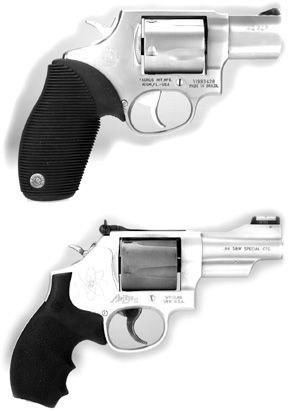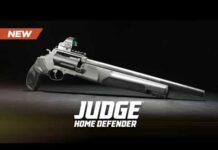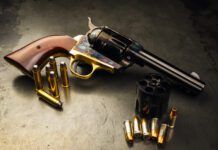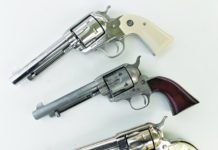
The snub-nosed revolver, distinguished by its short barrel measuring three inches or less, may forever remain the most basic of tools. But that does not mean its design has remained stagnant. Year after year we see new materials, chamberings, and design features offered in a small package. Though the classic caliber is .38 Special, some of the newest snubbies being offered feature big-bore cartridges. Two such revolvers are the .45 ACP Taurus M455, $525, and the Smith & Wesson 396-1 chambered for .44 Special, $794.
Actually the two guns are very different expressions of short-barreled revolver design. The Taurus is compact and heavy, fashioned from stainless steel. The new Smith & Wesson is much lighter. The 396-1 boasts a 3-inch barrel attached to a medium/large (L) frame rendered in ultralight materials. Both offer solid personal protection. We wanted to know the capabilities of these guns and what it was like to live with them every day, just like a second skin. We carried them legally and we shot them repeatedly over a two-week period. Here’s what we found.
Taurus M455 .45 ACP, $525
After our experience with other revolvers in the Tracker lineup, we were anxious to try the 2-inch version of the .45 ACP model we tested in the August 2002 issue. While the balance of the Taurus lineup is made up of solid choices, our experience is that the revolvers belonging to the Tracker series and also the big “Raging” revolvers represent Taurus’s best efforts to date. But we were a little confused when we received the M455.
Despite the adaptation of moonclips (which Taurus refers to as their Stellar clips) and the new contour cylinder release, our revolver did not resemble the other guns in the Tracker series. The Trackers we had previously tested had a much deeper looking full lug surrounding the barrel, with porting on the sides seated within a sculpted recess. Also, the Taurus website lists the Tracker .45 ACP revolvers as having adjustable sights on each model (2-, 4- or 6-inch barrels). Last, we weighed our snubbie to be some 8 ounces heavier than what was listed on the Taurus website. Perhaps the lack of adjustable sights and the placement of porting atop the barrel were compromise solutions due to the short barrel and the gun’s primary assignment, that of concealment. No picture of this model appears on the website, but in a recent advertisement we were able to visually confirm that the gun we received was indeed the snub-nosed version of the Tracker.
That being said the only feature that distinguishes this gun from the other steel revolvers in the catalog is the chambering of .45 ACP and the adaptation of the Stellar clips. We found these clips to be easily loaded and unloaded without the use of any special tool, and they always worked, even though we tended to abuse them. This is very good to know. While clips are very fast and a favorite with competitive shooters, they are often looked upon as a liability for carry. A bent clip can render an otherwise reliable wheelgun useless. The only drawback to this system is you need to load and unload the clips for each shot fired.
At the range we chose to collect accuracy data by firing single action only from a sandbag rest at 15 yards. Due to the compact design of this gun, we found it difficult to complete a double-action stroke with consistency because our support setup was more elaborate than usual due to blustery winds. In single-action mode the quality of chamber and bore alignment is key. The Taurus acquitted itself well with a variety of ammunition. We fired the same ammunition used in our test of Polymer 1911 .45s with 4-inch barrels found elsewhere in this issue. The pistols were tested at a greater distance due their adjustable sights and longer sight radii, but in a comparison of velocity at 10 feet from the muzzle the Taurus more than held its own. Despite its shorter barrel and cylinder gap, the M455 produced more velocity and greater muzzle energy than all three pistols, with only one exception. Granted, one must take into account temperature and light conditions that may influence chronograph readings, but being able to compare velocities at all between a 2-inch snubbie and a set of 4-inch pistols is remarkable.
[PDFCAP(2)]When we fired the gun single action, we were able to produce a smallest group of 2.2 inches with each of our test rounds. Furthermore, average group size for all shots fired measured less than 2.5 inches. So, in our opinion, this proves that cylinder to bore alignment in this revolver was not just true but tight as well.
While the single action was consistent, we didn’t feel as confident with the 455’s double-action fire. This is a gun we would want to be able to fire quickly, and we felt that our passes at the falling plate rack required too much attention. Clearer sights would help. The supplied rear sight is merely a notch in the top strap, which is a durable design but not visually fast. In terms of trigger control, the Taurus’ mainspring design creates a feel different from that of the leaf-spring revolvers such as the Smith & Wesson guns. Coiled mainsprings ask the shooter to first overcome its static resistance and then its final weight at compression. This is commonly referred to as stacking. This characteristic is more noticeable in smaller guns that typically use a shorter mainspring. But other mechanisms also play a part in the quality of a revolver’s action.
First there is the smooth interaction of the internal parts. But the final action of turning the cylinder as the hand reaches through the breach and contacts the ratchet is perhaps the most critical point in characterizing the double-action press. The ratchet is like an open face gear and is located in the center of the ejector star. The hand moves slightly forward, then up and away. We developed a test to measure how much resistance this adds to the weight of the double-action press. The weight of double-action pull we normally list includes bringing the hammer back and turning the cylinder with a random choice of corresponding chamber. This time we measured the press for each chamber individually. Then we swung out the cylinder and held back the cylinder latch freeing the trigger. This removes the weight of friction and inertia needed to turn the cylinder.
For the Taurus, chambers one through five measured 12.5, 11.75, 12.5, 12.5, and 11.5 pounds respectively. With the cylinder removed, the compound weight of the internal mechanism plus the mainspring measured 10.5 pounds. This means that turning the cylinder accounts for up to 2 pounds of weight of resistance at the trigger. Our other big-bore snubbie, Smith & Wesson’s model 396-1 in .44 Special, measured out to five presses of 13.5, 14, 14, 13.5, and 14 pounds respectively. The weight of press minus moving the Titanium cylinder was 12.2 pounds. While there is a margin of error here, it is interesting to note that even though the Smith & Wesson cylinder is much lighter, it still required about 2 pounds to move it against its locking features.
Visually comparing the ratchets of each gun, it is easy to see why the Smith & Wesson’s press is more consistent. However, we’re not sure how apparent 1 pound of trigger weight is to the shooter from one press to another. We learned to shoot the Taurus consistently, and feel that any of the simple refinements commonly available to its action would make this good little powerhouse even better. Another key would be practice, and with the comfort afforded by its soft grip, porting system, and overall weight, you will be able to do so without punishing your hands, as is the case in shooting a much lighter gun.
Smith & Wesson 396-1 Mountain Lite .44 Special, $794
Not long ago Smith & Wesson was producing enclosed-hammer revolvers that were similar to the Centennial J-frame series. One was a seven-shot .38 Special with 2-inch barrel and the other was chambered for .44 Special. These guns were based on the L-frame and maybe a little ugly. But they worked, and we especially liked the .44 Special model. Today, Smith & Wesson is producing another superlight L-frame with titanium frame and scandium cylinder. Scandium is not only as light and as strong as “Ti” but also offers the additional property of elasticity, making it more durable. This latest L-frame chambered for .44 Special is virtually the same gun we tested in our March 2002 issue, but with five bigger holes rather than seven chambers for .38 Special or .357 Magnum. The gun features an adjustable rear sight with V notch sight blade, and a HiViz light gathering front sight. We think this product is aptly named. One change from the earliest Mountain Lite is that the rear face of the piece that holds the filament is now serrated to remove glare. This makes it easier to see the glowing filament and the surrounding edges as well, should you desire a more traditional sight picture defined by light bars. Smart move on Smith & Wesson’s part, in our opinion.
This tall sight, however, makes it a little harder to find a proper holster. While we were able to use any number of holsters off the shelf for the Taurus revolver, the only holster in our collection that fit the gun was Bianchi’s 7/7L pancake holster. But the beauty of this gun is that it weighs only 22 ounces. This means when you put it in a holster, it stays close to the body, whereas most revolvers are top heavy and tend to flop outward.
This can give away concealment. Another giveaway can be a grip that is too long or made from a rubber that will grab clothing. The supplied grip is Hogue’s Bantam design, which slips on and off with a special tool rather than being held on by a screw. Even though the backstrap of this round butt revolver is left exposed by this grip, the combination of palm swell and finger grooves makes the Bantam an effective insulator against recoil. We tried mounting a series of wood and rubber grips, even another Hogue design, but the only thing we accomplished other than finding out that the Bantam was still the best grip was that the lanyard pin can slip off when the grip is removed. Some shooters may prefer to add porting to reduce felt recoil.
According to MagNaPort, (586) 469-6727, they have had success with the Smith & Wesson Ti and Sc revolvers but note that the ports must be placed just ahead of the frame instead of towards the muzzle. That is because the 3-inch stainless steel barrel is not flush mounted to the inside of the Titanium shroud at all points from the muzzle back. But it is our experience that a careful choice of ammunition can allay the needs for porting. While we found comfort more difficult to achieve firing magnum loads in the .38/.357 model, the selections of .44 Special were easier to live with. In fact, the test round that we fired with the most accuracy was also the most comfortable to shoot. This was PMC’s 180-grain JHP round, and it nearly equaled the power of the 200-grain Speer Gold Dot Hollow Points. The actual numbers are 276 foot-pounds versus 279 foot-pounds, but the Gold Dots were a real handful in comparison despite the small difference in power. In terms of performance, the more powerful was the .45 ACP Taurus. In terms of double-action fire at the plate rack, we would give the Smith & Wesson revolver the edge.
[PDFCAP(4)]The Ti/Sc guns from Smith & Wesson are formidable weapons. One change we would like to see is a longer ejector rod for sure ejection, and another is chamfered cylinders. You might need to reload quickly some day, especially if your gun is low capacity.
Unrelated directly to this gun, we did have a bad experience with a Sc/Ti gun shortly before we ran this test. Choosing to clean his gun with a spray cleaner, one staffer found the finish on the Ti portion of the gun came off like it was molting. Thus, these guns should not be sprayed with traditional cleaners. The finish is slick enough so that it can be adequately cleaned with the overrun from a proven mild bore cleaner such as Hoppe’s #9. One cleaner we did have nice results with that does come in a spray can is Browning Action Cleaner, which spreads with a foaming action.
Gun Tests Recommends
Taurus .45 ACP M455, $525. Buy It. It might be a little heavy for its capacity, but five shots of .45 ACP in this reliable revolver platform should be plenty of stopping power. More comfortable to shoot than most snubbies, it shouldn’t be difficult to stay in practice with it either.
Smith & Wesson .44 Special Model 396-1, $794. Our Pick. Even though this is not a small gun, its light weight makes the 396-1 concealable. Also, .44 Special may be the most suitable cartridge for this type of firearm. If “invisible power” is what you are after, your money will be well spent on this sidearm.




























